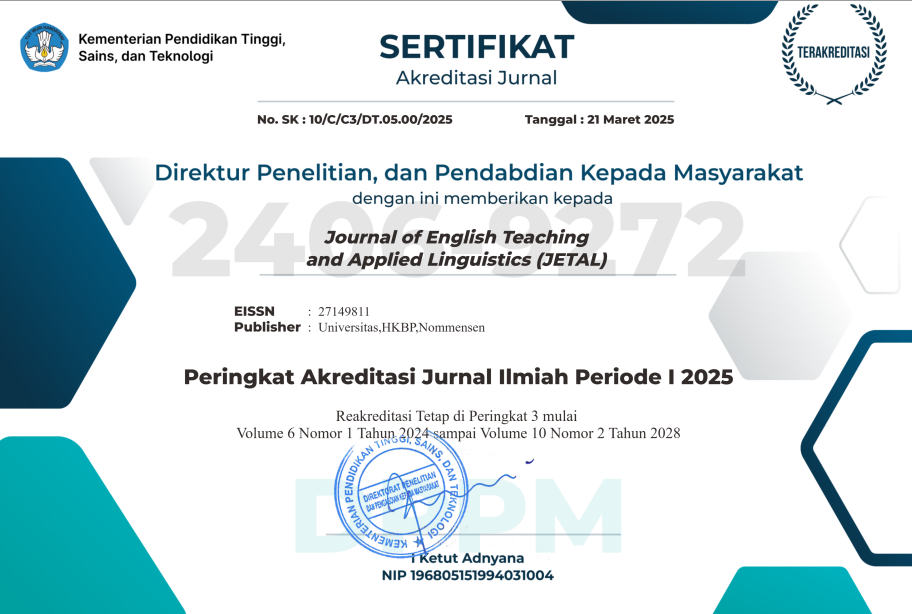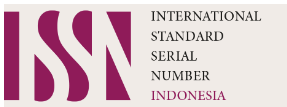Improving Students’ Vocabulary Acquisition and Reading Comprehension by Using the Extensive Reading Approach at Grade 8 of SMP Negeri 2 Silima Punggapungga Dairi
Abstract
This study investigates the effectiveness of the Extensive Reading approach in improving vocabulary acquisition and reading comprehension among eighth-grade students at SMP Negeri 2 Silima Punggapungga. Employing Classroom Action Research (CAR), the research was conducted in two cycles, each comprising planning, action, observation, and reflection stages. Data were collected through pretests, posttests, student observations, and teacher reflections. The findings indicate a significant improvement in students' vocabulary acquisition and reading comprehension. The mean vocabulary acquisition score increased from 50.78 in the pretest to 66.09 in Cycle 1 and 79.84 in Cycle 2. Similarly, reading comprehension scores rose from 51.25 in the pretest to 69.53 in Cycle 1 and 80.78 in Cycle 2. The results highlight the positive impact of Extensive Reading, particularly in enhancing students’ motivation, confidence, and independent learning habits. Students became more engaged in reading activities, demonstrated greater autonomy in learning, and exhibited a reduced reliance on translation. Despite these positive outcomes, challenges such as students' varying reading abilities and limited access to reading materials remain. Therefore, providing diverse and engaging reading resources and integrating technology-based reading platforms are recommended to support the sustainability of this approach. This study contributes to the growing body of research on language learning strategies, emphasizing the role of Extensive Reading in fostering literacy skills. Future research should explore its long-term impact and application in different educational settings to validate its effectiveness.
References
ADEOYE, M. A., PARAMOLE, O. C., JOLAOYE, J. D., & JIBRIL, A. O. (2024). Implementing Engaging Strategies to Cultivate Study Habits and Propel Academic Achievement among Secondary School Students. SOCIA: Jurnal Ilmu-Ilmu Sosial, 20(2). https://doi.org/10.21831/socia.v20i2.65956
Aguilar García, M. L. (2024). Vocabulary acquisition in the language classroom: what it is, how it works, which strategies and approaches are suitable for Latin instruction. Journal of Classics Teaching, 1–7. https://doi.org/10.1017/S2058631024000059
ALQAHTANI, M. (2015). The importance of vocabulary in language learning and how to be taught. International Journal of Teaching and Education, III(3), 21–34. https://doi.org/10.20472/te.2015.3.3.002
Alsaif, A., & Masrai, A. (2019). Extensive Reading and Incidental Vocabulary Acquisition: The Case of a Predominant Language Classroom Input. International Journal of Education and Literacy Studies, 7(2), 39. https://doi.org/10.7575/aiac.ijels.v.7n.2p.39
Arikunto, S. (2010). Prosedur Penelitian Suatu Pendekatan Praktik. Rineka Cipta.
Ateek, M. (2021). Extensive reading in an EFL classroom: Impact and learners’ perceptions. Eurasian Journal of Applied Linguistics, 7(1), 109–131. https://doi.org/10.32601/ejal.911195
Bal, P. M., & Veltkamp, M. (2013). How Does Fiction Reading Influence Empathy? An Experimental Investigation on the Role of Emotional Transportation. PLoS ONE, 8(1). https://doi.org/10.1371/journal.pone.0055341
Balan, S., Katenga, J. E., & Simon, A. (2019). Reading Habits and Their Influence on Academic Achievement Among Students at Asia Pacific International University. Abstract Proceedings International Scholars Conference, 7(1), 1490–1516. https://doi.org/10.35974/isc.v7i1.928
Bamford, J., & Day, R. R. (2004). Extensive reading activities for teaching language.
Berzak, Y., Katz, B., & Levy, R. (2018). Assessing language proficiency from eye movements in reading. NAACL HLT 2018 - 2018 Conference of the North American Chapter of the Association for Computational Linguistics: Human Language Technologies - Proceedings of the Conference, 1, 1986–1996. https://doi.org/10.18653/v1/n18-1180
Boutorwick, T. J., Macalister, J., & Elgort, I. (2019). Two approaches to extensive reading and their effects on L2 vocabulary development. Reading in a Foreign Language, 31(2), 150–172.
Brown, D. H. (2006). Principle of Language Learning and Teaching. In The Ultimate FE Lecturer’s Handbook. https://doi.org/10.1017/cbo9781139062398.015
Burns, A. (2009). Doing action research in english language teaching: A guide for practitioners. In Doing Action Research in English Language Teaching: A Guide for Practitioners. https://doi.org/10.4324/9780203863466
Castles, A., Rastle, K., & Nation, K. (2018). Ending the Reading Wars: Reading Acquisition From Novice to Expert. Psychological Science in the Public Interest, 19(1), 5–51. https://doi.org/10.1177/1529100618772271
Cunningham, Anne E., Stanovich, K. E. (2005). What Does Reading For The Mind. California Management Review, 48(1).
Day, R. R., Bamford, J., Renandya, W. A., Jacobs, G. M., & yu, V. W. S. (1998). Extensive reading in the second language classroom. RELC Journal, 29(2), 187–191. https://doi.org/10.1177/003368829802900211
Duke, N. K., & Cartwright, K. B. (2021). The Science of Reading Progresses: Communicating Advances Beyond the Simple View of Reading. Reading Research Quarterly, 56(S1), S25–S44. https://doi.org/10.1002/rrq.411
Fraenkel, Jack; Helen, Hyun; Walen, N. (2012). How to Design and Evaluate Research in Education (8th editio). Journal of American Optometic Association.
Harmer, J. (2007). The_Practice_of_English_Language_Teachin.pdf. In Longman Handbooks for Language Teaching Series (p. 386).
Junko Yamashita1, Y. j. (2013). Effects of extensive reading on reading attitudes in a foreign language. Reading in a Foreign Language, 25(2), 248–263.
Klauda, S. L., & Guthrie, J. T. (2015). Comparing relations of motivation, engagement, and achievement among struggling and advanced adolescent readers. Reading and Writing, 28(2), 239–269. https://doi.org/10.1007/s11145-014-9523-2
Krashen, S. (2007). Principles and Practice in Second Language Acquisition Principles and Practice in Second Language Acquisition Stephen D Krashen University of Southern California (Issue January 1982).
Krashen, S. D. (2004). The power of reading: Insights from the research. The Power of Reading: Insights from the Research, January 2004, 1–216. https://doi.org/10.2307/330145
Kumaravadivelu, B. (2006). Understanding Language Teaching: From Method to Post Method (p. 246).
L. Schmitt, Norbert, Meyer, L. (2002). Vocabulary in Language Teaching. TESOL Quarterly, 36(2), 235. https://doi.org/10.2307/3588334
Laufer, B., & Hulstijn, J. (2001). Incidental vocabulary acquisition in a second language: The construct of task-induced involvement. Applied Linguistics, 22(1), 1–26. https://doi.org/10.1093/applin/22.1.1
Liu, J., & Zhang, J. (2018). The Effects of Extensive Reading on English Vocabulary Learning: A Meta-analysis. English Language Teaching, 11(6), 1. https://doi.org/10.5539/elt.v11n6p1
M. Zaini Miftah. (2013). Implementation of Intensive-Extensive Reading Strategy To Improve Reading Comprehension. Journal on English as a Foreign Language, 3(1), 21–30.
Maipoka, S. A., & Soontornwipast, K. (2021). Effects of intensive and extensive reading instruction on thai primary students’ english reading ability. LEARN Journal: Language Education and Acquisition Research Network, 14(1), 146–175.
Maley, A. (2010). Creativity in the English Language Classroom. In Creativity in the English language classroom.
Manik, S., Sembiring, M., Sriulina, L., & Tarigan, B. (2021). The Effect of Cooperative Integrated Reading and Composition (CIRC) on Students’ Reading Comprehension Achievement. 4(3), 678–688. http://jayapanguspress.penerbit.org/index.php/cetta
Mikeladze, T. (2014). Extensive Reading. 1968(August 2014).
Monalisa. (2021). Praksis Membaca Ekstensif Mahasiswa Pendidikan Bahasa Inggris dan Implikasinys Terhadap Pengajaran. Jurnal Literasiologi, 5(2), 6.
Nation, I. S. P. (2013). Learning vocabulary in another language. Learning Vocabulary in Another Language, 1–624. https://doi.org/10.1016/s0889-4906(02)00014-5
Nation, K. (2019). Children’s reading difficulties, language, and reflections on the simple view of reading. Australian Journal of Learning Difficulties, 24(1), 47–73. https://doi.org/10.1080/19404158.2019.1609272
Nation, P. (2017). How Vocabulary is Learned. 12(1). http://ojs.atmajaya.ac.id/index.php/ijelt
Nur Fitria, T. (2023). Teaching Extensive Reading to EFL and Non-EFL Students: Benefits and Problems. ENJEL: English Journal of Education and Literature, 2(01), 76–85. https://doi.org/10.30599/enjel.v2i01.471
Perfetti, C. (2010). Decoding, vocabulary , and comprehension. In Mckeown, M.G. and Kucan, L. (eds.), Bringing reading research to life.
Perfetti, C., & Stafura, J. (2014). Word Knowledge in a Theory of Reading Comprehension. Scientific Studies of Reading, 18(1), 22–37. https://doi.org/10.1080/10888438.2013.827687
Permatasari, A. N., & Wienanda, W. K. (2023). Extensive Reading in Improving Reading Motivation: A Students’ Perspective. Eralingua: Jurnal Pendidikan Bahasa Asing Dan Sastra, 7(2), 220. https://doi.org/10.26858/eralingua.v7i2.45638
Pido, N. W. T., & Sujitno, F. D. C. (2022). The effect of digital technology on students’ reading Behavior. Journal of English Teaching and Linguistic Issues (JETLI), 1(2), 81–93. https://doi.org/10.57153/jetli.v1i2.210
Prapanca, T. A. (2020). Minat siswa kelas XI terhadap mata pelajaran tata boga di SMA negeri 1 temon. Universitas Negeri Yogyakarta, 59–60.
Richards, J. C., & Rodgers, T. S. (1986). Approaches and Methods in Language Teaching. In The Modern Language Journal (Vol. 70, Issue 4, p. 420). https://doi.org/10.2307/326829
Rindu, & Tuahman, K. (2023). Improving Students Reading Ability By Using Guided Reading Procedure ( GRP ) At Elementary School. Jurnal Scientia, 12(1), 69–74. http://infor.seaninstitute.org/index.php
Robb, T. N., & Susser, B. (1989). Extensive Reading vs Skills Building in an EFL Context. In Reading in a Foreign Language1 (Vol. 5, Issue 2, pp. 239–251).
Saville, M. (2006). Introducing Second Language Acquisition.
Scanlon, D. M., & Anderson, K. L. S. J. M. (2010). Early Intervention for Reading Dificulties. In The Guilford Press (Vol. 88, Issue 3).
Seidenberg, M. (2017). Language at the Speed of Sight: How We Read, Why so Many Can’t, and What Can Be Done about It. In Basic Books.
Sesma, H. W., Mahone, E. M., Levine, T., Eason, S. H., & Cutting, L. E. (2009). The contribution of executive skills to reading comprehension. Child Neuropsychology, 15(3), 232–246. https://doi.org/10.1080/09297040802220029
Sihem, H., & Salhi, A. (2015). Words in the Mind, Words in the Brain. The Mental Lexicon, 1(1), 1–15. https://doi.org/10.1075/ml.1.1.02whi
Simanjuntak, L. A., Manik, S., Sinambela, E., & Suprayetno, E. (2022). Improving Students’ Vocabulary Competence By Constructing Grammatical and Lexical Collocation At Gr Students’ Vocabulary Competence By Constructing Grammatical and Lexical Collocation At Grade Xi in Wellington Intelligence School. Jurnal Mutiara Pendidikan Indonesia, 7(1), 64–77. https://doi.org/10.51544/mutiarapendidik.v7i1.3009
Sipayung, K. (2021). Improving Students Vocabulary Through Bbc’S Video in Instagram At Junior High School. Epigram, 18(1), 32–36. https://doi.org/10.32722/epi.v18i1.3751
Subramaniam, S., & Zainal, Z. (2018). The Effect of Extensive Reading on Vocabulary Acquisition. LSP International Journal, 3(1), 63–82. https://doi.org/10.11113/lspi.v3n1.35
Universitas Negeri Jakarta. (2022). Reading Interest in Indonesia.
Vogler, P., Crivello, G., & Woodhead, M. (2008). Early Childhood Transitions Research: A Review of Concepts, Theory and Practice. In Bernard van Leer Foundation Working Paper in Early Childhood Development (Vol. 48).
W. A. Renandya, & H. (2021). classroom . In W . A . Renandya , & Handoyo , P . ( Eds .), English language teaching Chapter 8 Extensive Reading and Listening in the L2 Classroom 8 . 2 Extensive Reading. 97–110.
Wagner, R., & Meros, D. (2010). Vocabulary and Reading Comprehension: Direct, Indirect, and Reciprocal Influence. NIH Public Access, 1, 1–17.
Waring, R. (2011). Extensive reading in English language teaching. Innovation and Creativity in ELT Methodology, November, 69–80. https://doi.org/10.1093/elt/ccq076

This work is licensed under a Creative Commons Attribution-ShareAlike 4.0 International License.
Authors retain copyright and grant the journal right of first publication with the work simultaneously licensed under a Creative Commons Attribution-ShareAlike 4.0 International License (CC BY-SA 4.0) that allows others to share the work with an acknowledgment of the work's authorship and initial publication in this journal.
Authors are able to enter into separate, additional contractual arrangements for the non-exclusive distribution of the journal's published version of the work (e.g., post it to an institutional repository or publish it in a book), with an acknowledgment of its initial publication in this journal.
Authors are permitted and encouraged to post their work online (e.g., in institutional repositories or on their website) prior to and during the submission process, as it can lead to productive exchanges, as well as earlier and greater citation of published work (See The Effect of Open Access).





